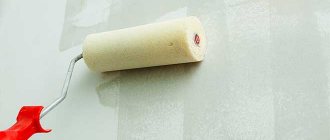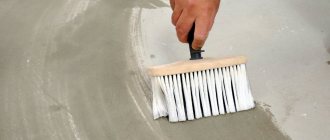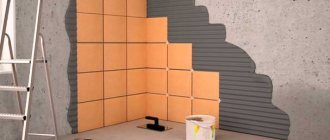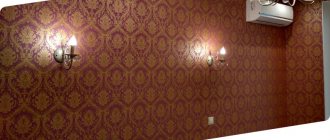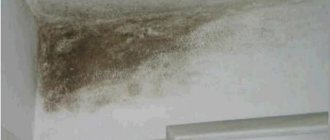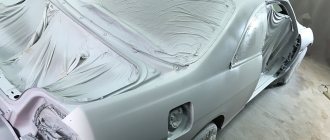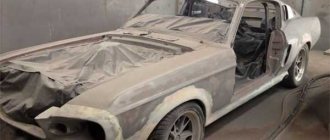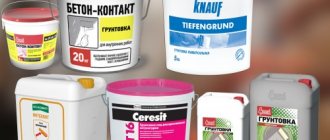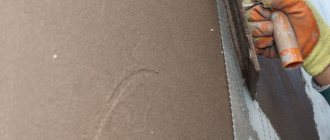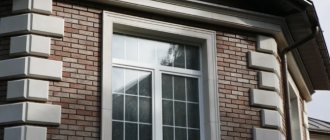Active use of a vehicle sooner or later leads to the appearance of various scratches, chips, and full-size dents on its paintwork. If minor defects can still be somehow ignored, then large ones will have to be dealt with for at least two main reasons. Firstly, it is simply unaesthetic, and the more expensive and reputable the car, the more noticeable the defect is. Secondly, for purely practical reasons: absolutely any scratch can expose the surface of the base metal, which over time will cause its corrosion and destruction.
The solution to the problem is car painting. But before this, the corresponding surfaces must be carefully processed and prepared using primer and putty to prevent damage to the integrity of the coating. Here, novice painters (or those car enthusiasts who are trying to master this process on their own) often have a question: is a primer applied under the putty or vice versa?
Do I need to prime the walls before puttingty after plastering?
The primer composition must be applied without fail. Both walls and ceilings need to be treated. This approach allows you to strengthen the surface and improve absorbency, as well as increase the adhesion of the layers together with the topcoat. Therefore, to the question - is it necessary to prime before puttying, the answer is affirmative.
Why do you need a primer for putty?
Plaster is capable of absorbing moisture more and has a fairly rough surface that requires further processing. And when the question arises whether it is necessary to prime the plaster before puttying, it should be taken into account that the density of the former is much lower than that of concrete, and the porosity is greater.
These conditions indicate that the surface needs to be puttied for further finishing. This way you can avoid a rough coating that will show its marks through the finishing material. And the more intense the layer of plaster, the weaker it will adhere and the faster it will peel off.
However, in the process of laying putty on a porous and moisture-absorbing surface, the composition instantly loses its plasticity, and as a result it becomes difficult to level.
In addition, in such a situation, particles often separate from the spatula, which will leave damage and gaps on the base prepared for the putty. Priming allows you to avoid these problems and will help strengthen the layer of future putty to a fairly impressive depth, as well as avoid porosity and moisture penetration.
Interesting! The composition of the primer differs from concrete in the absence of impressive penetration and the ability to saturate the wall to a sufficient depth.
How to properly prepare drywall for painting?
To prepare
The surface to be
painted
must be thoroughly puttied in all its problem areas. For this we will need putty (you can take a larger volume, especially if you want to later make an original cabinet or any other complex structure).
Interesting materials:
What is bitumen made from? What is made from beech? What is made from pure aluminum? What is made from Chubushnik? What is birch wood made from? What is spruce wood made from? What is made from wood dust? What is made from spruce and pine? What is made from rosin? What is made from chemical fibers?
Choosing a composition for different surfaces
Despite the same purpose, there are a large number of varieties of primer that are suitable for different substrates. If you neglect and do not take this condition into account, and use the material for other purposes, you can only do harm, and the finished surface will not be as ideal as you want it to be.
For wood
There are different types of primer, which is intended for treatment before puttying, which differ in penetration depth and composition.
This:
- Adhesive (alkyd). These are supposed to be alkyd-based compositions that require deep impregnation. The material consists of small particles. They are well absorbed into the wood material and harden in it, making the fibers stronger. These compounds are needed in cases where it is necessary to obtain adhesion between different types of surfaces.
- Acrylate (leveling). Such primers may contain polymers of latex, vinyl or styrene. The particles of acrylate primers are quite large and leave a significant dry residue on the surface. These types of primers are not absorbed, but are distributed over the surface and fill all its gaps. In this way, you can level out various defects and cover the material with an invisible protective film. This type of primer is relevant for further painting. With it, the surface is free from spotting and reduces the consumption of finishing material.
The advantages of soil mixtures for a wooden base are as follows:
- The ability to level the surface and hide defects;
- Extending service life;
- Possibility to save on paint and varnish materials during finishing;
- Giving an aesthetic appearance;
- Ensuring reliable adhesion between the main surface and a further layer of decorative material (paint or varnish);
- Protecting wood flooring from attack by mold, mildew and other diseases.
For concrete walls
Such a primer composition for putty should have an antiseptic and vapor-permeable effect. Under plaster, it is important to use a primer that penetrates deeply through such a hard and dense base.
A reliable soil composition for concrete assumes the following properties:
- Uniform application;
- Increased water resistance;
- Formation of a water-repellent layer;
- Deep impact.
From plasterboard
Drywall itself is a material that is far from finished. As usual, it is painted, bleached or covered with wallpaper and even tiles. Therefore, the answer to the question of how to prime walls before puttying is so that the finishing coating firmly covers the layer of finishing materials. In this situation, the composition improves adhesion and protects the material from various influences.
Important! Drywall primer is a must.
A primer that is suitable for drywall should have the following properties:
- When installing heavy wallpaper or tiles, it is better to use a composition that has deep penetration and improves good connection with drywall.
- If the repair is carried out in a room with high humidity, a moisture-resistant primer is needed.
- When the finishing coating is light wallpaper, a composition with surface penetration and fairly low adhesion properties is suitable.
Advice! In order to prime drywall, you can use a universal acrylic-based mixture.
This composition is characterized by high hygroscopic properties and good adhesion, and also does not contain toxins, has sufficient breathability and dries quickly.
The drywall primer must be compatible with the finishing material. Especially with paint, which can be added in small quantities to the mixture itself
Putty on plasterboard sheathing
Much of what was said in the previous chapter also applies to puttying the surface of drywall. In particular, either a special primer for drywall under putty should be used, or the composition should be universal. Let us add on our own that it is better to take both gypsum board sheets, primer, and putty composition from the same manufacturer.
- Price does not play any role here - the main thing is that in this case you can be sure of the best compatibility of materials. Priming and puttying of drywall is carried out using a long-established technology: first sealing the joints between the sheets, and then puttingty over the entire surface.
- Although it is believed that the surface of the plasterboard does not need to be puttied before wallpapering. Note that when using dense and embossed rolled materials, this is really not required. Moreover, the paper base of the wallpaper is tightly glued to the cardboard shell of the drywall. This results in savings on putty - but this can become a problem if you decide to update the interior.
- It is almost impossible to remove wallpaper from unputtyed gypsum board sheets without spoiling their surface - the wallpaper sheets will be torn off, as they say, “with meat”. This is the same case when a stingy owner needs to pay twice: it is possible that the entire lining will have to be changed. So it’s better to spend money on putty.
- In this case, surface preparation is performed in the following sequence. First, the seams are primed, and after the composition has dried, they are filled with putty. At the same time, they cover the places where the sheets were fastened with self-tapping screws. Then, until the mixture has hardened, the joints are glued with sickle tape, pressing it well into the solution, and again allow time to dry.
Next, primer is applied over the entire surface, after which putty is applied. One layer is usually sufficient, since the sheathing is even.
When the screed has dried, it is lightly sanded with an abrasive mesh or fine sandpaper. The resulting dust is removed with a vacuum cleaner, and the room is wet cleaned. All that remains is to carry out the final priming - and the surface is ready for painting or pasting.
Source
How long after priming can I putty a second time?
In addition to the question of whether it is necessary to prime the walls before puttying or not, many are interested in the time after which they can begin subsequent finishing. So, if the treatment was carried out on a cement-sand base, it is recommended to start the next stage of work no earlier than after 2-3 hours. And if the process involved priming a cement-lime composition, you need to wait 4-6 hours.
Primed wood can dry in 1-2 hours, depending on its characteristics. And concrete dries the fastest (within 30 minutes).
Attention! The putty layer, which is applied over the undried primer, moistens it excessively. So, the surface will roll off and peel off with further painting or gluing. Therefore, you need to wait until the layer is completely dry.
Rules, tips, recommendations
The process of treating walls before applying putty should be carried out in compliance with the following steps:
- Checking the temperature conditions for compliance;
- Careful preparation of the surface for the base;
- Proper dilution of the soil composition (in the correct proportions);
- Correct application of the mixture to the surface to be mounted.
Wherein:
- The soil mixture must be selected depending on the material to be processed and operating conditions. For example, with dampness, frost, sun and elevated temperatures, increased protective properties are needed that correspond to these features.
- When diluting the composition with water, you should pay attention to the proportions indicated on the packaging.
- Do not rush and apply putty. The walls should be thoroughly dried.
- It is strictly not recommended to replace primer with paint. These are 2 completely different in their purpose and composition characteristics.
As a conclusion, in response to the question of whether it is necessary to prime the walls before puttying, it should be said that it is necessary and even mandatory. At the same time, you should not save materials and time, which during application is not so long. It is important to choose the right composition for the characteristics of the surface to which it is applied.
Also, among a large number of varieties, you need to choose mainly a reputable brand that will actually give good results.
Temperature
Compliance with temperature indicators during the process of external and internal finishing work is one of the fundamental points. Work on puttying walls can be carried out at any time of the year, provided that the temperature conditions are observed.
Regardless of the wall material, the temperature should not be lower than +5 degrees, and the humidity should not be 10% during interior work. The putty should not freeze, otherwise after drying the mixture may crumble or burst.
For external finishing work, the temperature must be no lower than -5 degrees and the humidity no more than 60%, and you will also need to use specialized solutions with anti-freeze additives.
The point that requires attention is that you will need to worry about drying the layer and proper ventilation.

